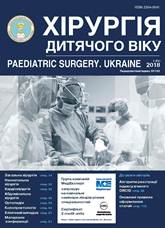Laparoscopic or laparotomic techniques for the colostomy formation in newborns with anorectal atresia?
DOI:
https://doi.org/10.15574/PS.2018.59.64Keywords:
newborns, children, paediatric surgery, anorectal malformations, anal atresia, colostomyAbstract
The incidence rate of anorectal malformations is 1 in 4000–5000 live births and characterized by a wide range of options. The specialized in this problem surgeons often choose the staging treatment approach, and the question of gut exteriorization often rises already in the neonatal period.Objective: to analyze the results of the colostomy formation in children with anorectal malformations, primarily operated in the neonatal period by using laparotomic and laparoscopic techniques.
Materials and methods. In the paediatric surgery clinic of the Tyumen SMU, 52 newborns were treated with anorectal atresia with average body weight 3172.5±694.99 grams during the period of 2010–2016. There were 32 males and 20 females. A double separated stoma, as the first stage of the defect correction, was performed in 48 children, moreover in 31 (59.6%) children; it was done urgently in the neonatal period.
Results and conclusions. Analysis of the postoperative course showed that the use of laparoscopy for colostomy as compared to laparotomy allows faster stabilizing the gastrointestinal transit, earlier feeding and reducing the time of the child’s hospital stay.
References
Averin VI, Ionov AL, Karavaeva SA, Komisarov IA, Kotin AN i dr. (2015). Anorektalnyie malformatsii u detey. Federalnyie klinicheskie rekomendatsii. Detskaya hirurgiya. 4: 29–35.
Akselrov MA. (2012). Iskusstvennyie kishechnyie svischi v abdominalnoy hirurgii u detey (sovershenstvovanie metodov formirovaniya, prognozirovanie posleoperatsionnogo techeniya, lechenie i profilaktika oslozhnenii). Omsk.
Degtyarev YuG. (2014). Vrozhdennyie anorektalnyie anomalii: diagnostika, lechenie. Meditsinskiy zhurnal. 2(48): 53–59.
Ivanov PV, Kirgizov IV, Baranov KN, Shishkin IA. (2010). Etapnoe lechenie anorektalnyih porokov u detey. Meditsinskiy vestnik Severnogo Kavkaza. 19; 3: 88–89.
Lenyushkin AI. (1999). Hirurgicheskaya koloproktologiya detskogo vozrasta. Moskva: Meditsina: 164-206.
Razin MP i dr. (2018). Detskaya hirurgiya. Uchebnik. Moskva: GEOTAR-Media: 136-141.
Cho S, Moore S, Fangman T. (2001). One hundred three consecutive patients with anorectal malformations and their associated anomalies. Arch. Pediatr. Adolesc. Med. 155: 587–591. https://doi.org/10.1001/archpedi.155.5.587; PMid:11343503
Christensen K, Madsen C, Hauge M, Kock K. (1990). An epidemiological study of congenital anorectal malformations: 15 Danish birth cohorts followed for 7 years. Paediatr. Perinat. Epidemiol. 4: 269–275. https://doi.org/10.1111/j.1365-3016.1990.tb00650.x; PMid:2374746
http://mkb-10.com/index.php?pid=16307
Stoll C, Alembik Y, Roth M, Dott B. (1997). Risk factors in congenital anal atresias. Ann. Genet. 40: 197–204. PMid:9526612
Downloads
Issue
Section
License
The policy of the Journal “PAEDIATRIC SURGERY. UKRAINE” is compatible with the vast majority of funders' of open access and self-archiving policies. The journal provides immediate open access route being convinced that everyone – not only scientists - can benefit from research results, and publishes articles exclusively under open access distribution, with a Creative Commons Attribution-Noncommercial 4.0 international license(СС BY-NC).
Authors transfer the copyright to the Journal “PAEDIATRIC SURGERY.UKRAINE” when the manuscript is accepted for publication. Authors declare that this manuscript has not been published nor is under simultaneous consideration for publication elsewhere. After publication, the articles become freely available on-line to the public.
Readers have the right to use, distribute, and reproduce articles in any medium, provided the articles and the journal are properly cited.
The use of published materials for commercial purposes is strongly prohibited.

